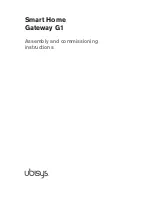
Event
An informational message used for
monitoring network status.
F
F-connector
The type of connector used on coax cable.
There are two common types of F-
connector, slip-on and screw-on. Use coax
with screw-on connectors for connecting
your Telephony Gateway.
Firewall
A hardware or software device that
prevents unauthorized access to a private
network from the Internet. The TG862G
provides a built-in firewall.
G
Gateway
The device, usually a router, that connects
devices on a given IP subnet to other IP
subnets.
H
Headend
The “central office” in an HFC network. The
headend houses both video and data
equipment. In larger cable networks, a
“master” headend often feeds several
“remote” headends to provide distributed
services.
HTTP
HyperText Transfer Protocol.
Hub
A box with several Ethernet connectors.
Ethernet hubs provide a common point of
contact for all connected devices.
I
IP address
A number assigned to your computer by
your service provider, used to identify your
computer to other systems on the
Internet.
ISDN
Integrated Services Digital Network. A
digital telephony standard that provides
communication speeds about twice as fast
as standard dialup.
L
LAN
Local Area Network. A network that allows
computers in a single location (such as a
building) to communicate with one
another.
LED
Light Emitting Diode. A semi-conductor
diode that emits light when current is
passed through it.
M
MAC address
A number that uniquely identifies any
device connected to a network. Your
service provider uses your Telephony
Gateway’s MAC address to authorize
access to the Internet. The MAC address is
printed on a label on the bottom of your
Telephony Gateway.
P
Protocol
A set of rules and formats that determines
the communication behavior of network
entities at a given layer.




































